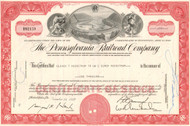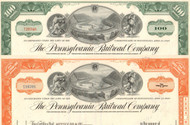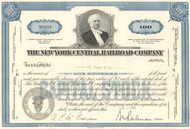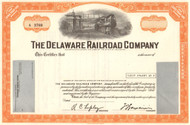Categories
Categories
- Home
- Railroad
- Modern Railroads
- Pennsylvania Railroad 1960's (Horseshoe Curve)
Pennsylvania Railroad 1960's (Horseshoe Curve)
Product Description
Pennsylvania Railroad Company stock certificate 1960's
Common but collectible Pennsylvania RR cert with the famous horseshoe curve vignette (opened 1854,engineered by J. Edgar Thompson. Located at Kittaning Point, at the base of the Allegheny Mountains.) This classic cert is a great starter piece for any collection. Available in green, orange, red, or set of 2 colors. This cert makes a stunning gift at an affordable price.
The Pennsylvania Railroad was founded in 1846. Commonly referred to as the "Pennsy," the PRR was headquartered in Philadelphia, Pennsylvania. The PRR was the largest railroad by traffic and revenue in the U.S. for the first half of the twentieth century. Over the years, it acquired, merged with or owned part of at least 800 other rail lines and companies. At the end of 1925, it operated 10,515 miles of rail line; in the 1920s, it carried nearly three times the traffic as other railroads of comparable length, such as the Union Pacific or Atchison, Topeka & Santa Fe railroads. Its only formidable rival was the New York Central , which carried around three-quarters of PRR's ton-miles.
At one time, the PRR was the largest publicly traded corporation in the world, with a budget larger than that of the U.S. government and a workforce of about 250,000 people. The corporation still holds the record for the longest continuous dividend history: it paid out annual dividends to shareholders for more than 100 years in a row. In 1968, PRR merged with rival NYC to form the Penn Central Transportation Company, which filed for bankruptcy within two years. The viable parts were transferred in 1976 to Conrail, which was itself broken up in 1999, with 58 percent of the system going to the Norfolk Southern Railway, including nearly all of the former PRR. Amtrak received the electrified segment east of Harrisburg.
The Pennsylvania Railroad (PRR) was originally a line from Philadelphia to Pittsburgh. Much of the railroad's subsequent expansion was accomplished by leasing or purchasing the following additional railroads:
Pittsburgh, Fort Wayne & Chicago Railway (PFtW&C)
Pittsburgh, Cincinnati, Chicago & St. Louis Railroad (PCC&StL)
Little Miami Railroad (to Cincinnati)
Northern Central Railway (Baltimore-Sunbury, Pennsylvania)
Philadelphia, Baltimore & Washington Railroad
Philadelphia & Trenton Railroad
United New Jersey Railroad & Canal Company (to New York City)
Philadelphians were slow to recognize that the Erie Canal and the National Railway were funneling to New York and Baltimore commerce that might have come to Philadelphia. A canal was opened in 1827 between the Schuylkill and Susquehanna rivers, and another was proposed along the Susquehanna, Juniata, Conemaugh, and Allegheny to link Philadelphia and Pittsburgh. That project was declared impractical, and in 1828 the Main Line of Public Works was chartered to build a railroad from Philadelphia to Columbia, another across the mountains, and canals from Columbia and from Pittsburgh to the base of the mountains.
By 1832 canals were open from Columbia to Hollidaysburg and from Pittsburgh to Johnstown; in 1834 a railroad was opened from Philadelphia to Columbia and a portage railroad was opened over the mountains. The latter, the Allegheny Portage Railroad, was a series of rope-operated inclined planes; canal boats were designed to be taken apart and hauled over the mountains. The pace of the state's action increased when the Baltimore & Ohio Railroad (B&O) requested a charter for a line to Pittsburgh. The B&O line was chartered, but so was the PRR, on April 13, 1846 — to build a railroad from Harrisburg to Pittsburgh with a branch to Erie. B&O's charter would be valid only if the PRR were not constructed.
Construction began in 1847. By late 1852 rails ran from Philadelphia to Pittsburgh, via a connection with the Allegheny Portage Railroad between Hollidaysburg and Johnstown. The summit tunnel was opened in February 1854, bypassing the inclined planes and creating a continuous railroad from Harrisburg to Pittsburgh. More than half of the line had already been double-tracked.
Timeline of the Pennsylvania Railroad:
1846: PRR is chartered to construct a rail line from Harrisburg to Pittsburgh, Pennsylvania.
1850: Construction begins on Altoona Works repair shop at Altoona, Pennsylvania.
1860–1890: PRR expands throughout the eastern U.S.
1869: PRR leases the Pittsburgh, Ft. Wayne & Chicago
1885: The Congressional Limited Express from New York City-Washington, D.C. is introduced
1887: Pennsylvania Limited service begins between New York-Chicago
1894: The Pennsylvania Pacific Corporation is formed by the PRR.
1902: Pennsylvania Special service begins between New York and Chicago
1906: An accident in Atlantic City kills 53 people
1910: Completion of the North River Tunnels under the Hudson River
1912: Broadway Limited was inaugurated, replacing the Pennsylvania Special.
1915: PRR electrifies its suburban Philadelphia lines to Paoli, Pennsylvania.
1916: PRR adopts new motto, Standard Railroad of the World.
1917: Completion of the New York Connecting Railroad and the Hell Gate Bridge
1928–1938: PRR electrifies its New York–Washington, D.C. and Chicago–Philadelphia line
1943: An accident at Frankford Junction, Pennsylvania kills 79.
1946: PRR reported a net loss for the first time in its history.
1951: An accident in Woodbridge, New Jersey kills 85 people.
1957: Steam locomotives are removed from active service in the PRR fleet.
1968: PRR merges with NYC to form the Penn Central Transportation Company.
 Loading... Please wait...
Loading... Please wait... 








